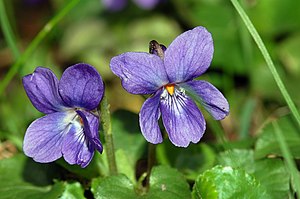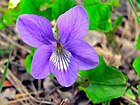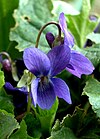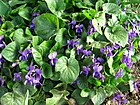Note: This is a project under development. The articles on this wiki are just being initiated and broadly incomplete. You can Help creating new pages.
Difference between revisions of "Viola odorata - Violet wood"
m (Prabhakar moved page Wood violet (Viola odorata) to Viola odorata - Wood violet) |
|||
| Line 1: | Line 1: | ||
[[File:Viola odorata fg01.JPG|thumb|right|''Viola odorata'']] | [[File:Viola odorata fg01.JPG|thumb|right|''Viola odorata'']] | ||
| − | '''Viola odorata''' is a species of the genus Viola native to Europe and Asia, but has also been introduced to North America and Australia | + | '''Viola odorata''' is a species of the genus Viola native to Europe and Asia, but has also been introduced to North America and Australia. |
| − | == | + | ==Uses== |
| + | {{Uses|abdominal pain}}, {{Uses|swelling}}, {{Uses|digestion problems}}, {{Uses|heartburn}}, {{Uses|gallbladder disorders}}, {{Uses|stuffy nose}}, {{Uses|coughs}}, {{Uses|hoarseness}}, {{Uses|Sore throats}} | ||
| − | + | ==Parts Used== | |
| + | {{Parts Used|Flowers}}, {{Parts Used|leaves dried}}, {{Parts Used|whole plant fresh}}. | ||
| − | + | ==Chemical Composition== | |
| − | + | Leaves of Viola odorata from Kashmir are reported to contain a triterpene ketone, probably friedelin (0.016%), Beta-sitosterol (0.033%), and a straight-chain alcohol<ref name="chemical composition"/> | |
| − | |||
| − | |||
| − | |||
| − | |||
| − | + | ==Common names== | |
| + | {{Common names|kn=|ml=|sa=|ta=|te=|hi=|en=Agrimony}} | ||
| − | == | + | ==Properties== |
| + | Reference: Dravya - Substance, Rasa - Taste, Guna - Qualities, Veerya - Potency, Vipaka - Post-digesion effect, Karma - Pharmacological activity, Prabhava - Therepeutics. | ||
| + | ===Dravya=== | ||
| − | + | ===Rasa=== | |
| − | + | Madhura (Sweet), Tikta (Bitter), Katu (Pungent) | |
| − | + | ===Guna=== | |
| − | + | Laghu (Light), Snigdha (Unctuous) | |
| + | ===Veerya=== | ||
| + | Ushna (Hot) | ||
| + | ===Vipaka=== | ||
| + | Katu (Pungent) | ||
| + | ===Karma=== | ||
| + | Kapha, Vata | ||
| + | ===Prabhava=== | ||
| − | == | + | ==Habit== |
| + | {{Habit|Herb}} | ||
| − | + | ==Identification== | |
| + | ===Leaf=== | ||
| + | {{Leaf|Simple|basal|The leaves are lobed or unlobed but not separated into leaflets}}<ref name="Leaf"/> | ||
| − | == | + | ===Flower=== |
| + | {{Flower|Unisexual|2-4cm long|blue to purple, white|1-2|Flowers Season is June - August and the flower is bilaterally symmetrical}} | ||
| + | |||
| + | ===Fruit=== | ||
| + | {{Fruit|General|5–8 mm|the fruit is dry and splits open when ripe|With hooked hairs|-}} | ||
| + | |||
| + | ===Other features=== | ||
| + | |||
| + | ==List of Ayurvedic medicine in which the herb is used== | ||
| + | * [[Vishatinduka Taila]] as ''root juice extract'' | ||
| + | |||
| + | ==Where to get the saplings== | ||
| + | ==Mode of Propagation== | ||
| + | {{Propagation|Seeds}}, {{Propagation|Cuttings}}. | ||
| + | |||
| + | ==How to plant/cultivate== | ||
| + | One of the essential points for the successful cultivation of Violets, either for the sake of marketing the cut blooms, or for medicinal purposes, is clear atmosphere. They seldom do well near a town, because the undersides of the leaves are covered with hairs, which catch the grit, thus blocking the breathing pores.<ref name="How to plant/cultivate"/> | ||
| + | |||
| + | ==Commonly seen growing in areas== | ||
| + | {{Commonly seen|hedgerows and woodlands}}, {{Commonly seen|especially on calcareous soils}}. | ||
| + | |||
| + | ==Photo Gallery== | ||
| + | <gallery class="left" caption="" widths="140px" heights="140px"> | ||
| + | |||
| + | Common Violet (Viola odorata) (8337402801).jpg | ||
| − | <references> | + | Devon Violets. Viola odorata (33624079715).jpg |
| − | <ref name=" | + | |
| − | <ref name=" | + | |
| − | <ref name=" | + | DSCN2408.JPG |
| + | |||
| + | |||
| + | Fialky.jpg | ||
| + | |||
| + | |||
| + | Fiołek wonny Las Bemowski.jpg | ||
| + | |||
| + | |||
| + | Flora della Sardegna 215 (01).JPG | ||
| + | |||
| + | </gallery> | ||
| + | |||
| + | ==References== | ||
| + | |||
| + | <references> | ||
| + | <ref name="chemical composition">[https://www.bimbima.com/herbs/viola-odorata/3869/ "chemical constituents"]</ref> | ||
| + | |||
| + | <ref name="Leaf">[https://gobotany.newenglandwild.org/species/viola/odorata/ "plant Characteristics"]</ref> | ||
| + | |||
| + | <ref name="How to plant/cultivate">[https://botanical.com/botanical/mgmh/v/vioswe12.html "cultivation details"]</ref> | ||
</references> | </references> | ||
| − | == External Links == | + | ==External Links== |
| + | * [https://www.webmd.com/vitamins/ai/ingredientmono-212/sweet-violet Viola odorata on webmd.com] | ||
| + | * [https://www.bimbima.com/herbs/viola-odorata/3869/ Banfsha (Viola odorata) Information, benefits, Warnings and More] | ||
| + | * [http://ijapr.in/index.php/ijapr/article/view/646 Viola odorata on International Journal of Ayurveda and Pharma Research] | ||
| + | * [https://easyayurveda.com/2015/04/22/vanapsa-viola-odorata-uses-research-side-effects/ Viola odorata on easyayurveda.com] | ||
| − | |||
[[Category:Herbs]] | [[Category:Herbs]] | ||
Revision as of 17:16, 14 June 2018
Viola odorata is a species of the genus Viola native to Europe and Asia, but has also been introduced to North America and Australia.
Contents
- 1 Uses
- 2 Parts Used
- 3 Chemical Composition
- 4 Common names
- 5 Properties
- 6 Habit
- 7 Identification
- 8 List of Ayurvedic medicine in which the herb is used
- 9 Where to get the saplings
- 10 Mode of Propagation
- 11 How to plant/cultivate
- 12 Commonly seen growing in areas
- 13 Photo Gallery
- 14 References
- 15 External Links
Uses
abdominal pain, swelling, digestion problems, heartburn, gallbladder disorders, stuffy nose, coughs, hoarseness, Sore throats
Parts Used
Flowers, leaves dried, whole plant fresh.
Chemical Composition
Leaves of Viola odorata from Kashmir are reported to contain a triterpene ketone, probably friedelin (0.016%), Beta-sitosterol (0.033%), and a straight-chain alcohol[1]
Common names
| Language | Common name |
|---|---|
| Kannada | |
| Hindi | |
| Malayalam | |
| Tamil | |
| Telugu | |
| Marathi | NA |
| Gujarathi | NA |
| Punjabi | NA |
| Kashmiri | NA |
| Sanskrit | |
| English | Agrimony |
Properties
Reference: Dravya - Substance, Rasa - Taste, Guna - Qualities, Veerya - Potency, Vipaka - Post-digesion effect, Karma - Pharmacological activity, Prabhava - Therepeutics.
Dravya
Rasa
Madhura (Sweet), Tikta (Bitter), Katu (Pungent)
Guna
Laghu (Light), Snigdha (Unctuous)
Veerya
Ushna (Hot)
Vipaka
Katu (Pungent)
Karma
Kapha, Vata
Prabhava
Habit
Identification
Leaf
| Kind | Shape | Feature |
|---|---|---|
| Simple | basal | The leaves are lobed or unlobed but not separated into leaflets |
Flower
| Type | Size | Color and composition | Stamen | More information |
|---|---|---|---|---|
| Unisexual | 2-4cm long | blue to purple, white | 1-2 | Flowers Season is June - August and the flower is bilaterally symmetrical |
Fruit
| Type | Size | Mass | Appearance | Seeds | More information |
|---|---|---|---|---|---|
| General | 5–8 mm | the fruit is dry and splits open when ripe | With hooked hairs | - | {{{6}}} |
Other features
List of Ayurvedic medicine in which the herb is used
- Vishatinduka Taila as root juice extract
Where to get the saplings
Mode of Propagation
How to plant/cultivate
One of the essential points for the successful cultivation of Violets, either for the sake of marketing the cut blooms, or for medicinal purposes, is clear atmosphere. They seldom do well near a town, because the undersides of the leaves are covered with hairs, which catch the grit, thus blocking the breathing pores.[3]
Commonly seen growing in areas
hedgerows and woodlands, especially on calcareous soils.
Photo Gallery
References
External Links
- Ayurvedic Herbs known to be helpful to treat abdominal pain
- Ayurvedic Herbs known to be helpful to treat swelling
- Ayurvedic Herbs known to be helpful to treat digestion problems
- Ayurvedic Herbs known to be helpful to treat heartburn
- Ayurvedic Herbs known to be helpful to treat gallbladder disorders
- Ayurvedic Herbs known to be helpful to treat stuffy nose
- Ayurvedic Herbs known to be helpful to treat coughs
- Ayurvedic Herbs known to be helpful to treat hoarseness
- Ayurvedic Herbs known to be helpful to treat Sore throats
- Herbs with Flowers used in medicine
- Herbs with leaves dried used in medicine
- Herbs with whole plant fresh used in medicine
- Herbs with common name in English
- Habit - Herb
- Index of Plants which can be propagated by Seeds
- Index of Plants which can be propagated by Cuttings
- Herbs that are commonly seen in the region of hedgerows and woodlands
- Herbs that are commonly seen in the region of especially on calcareous soils
- Herbs






